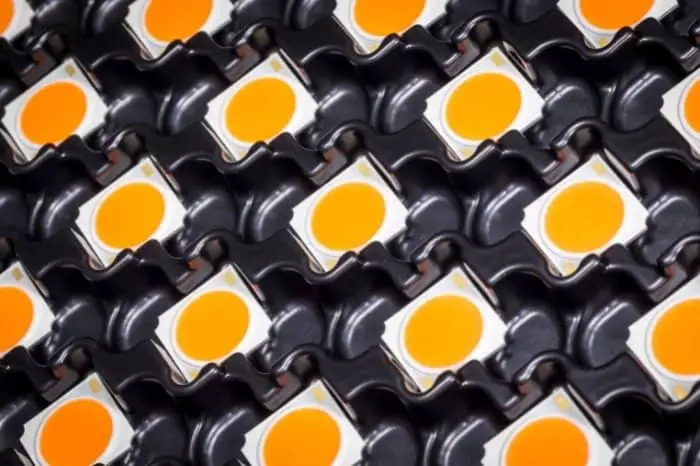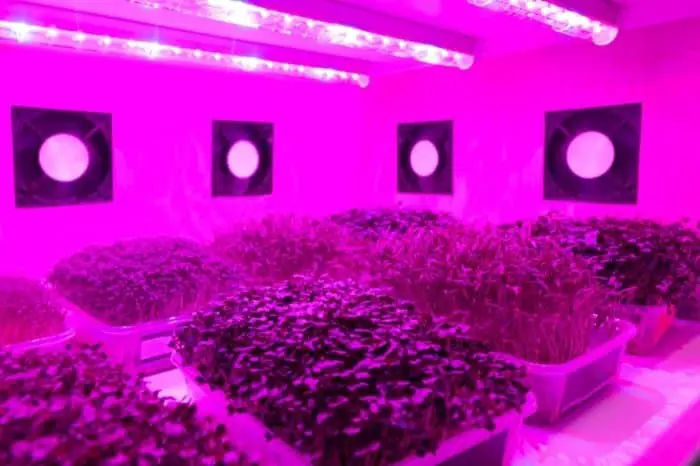Last Updated on October 29, 2022
Let’s discuss COB vs SMD LED for growing plants. In the grow light technology, there has been continuous improvement in various LED lights to offer a better yield.
LED lights are very popular and preferred by many indoor growers because of their durability and efficiency. They are also less power-consuming. However, not all LED models are the same. There are different models of LED in the market today which COB and SMD are one of them. But what differentiates these two great LED models? We will be discussing what COB vs SMD LED will offer your plants for their growing needs. So, continue reading to be informed.
COB Grow Light
First, we define what COB LED grow light design is. COB which stands for Chip On Board and it is one of the most recent LED light technology developed. COB is known to be more heat efficient and offers better or quality lumen per wattage. This is thanks to the great COB LED design as well as the substrate chips of their cooling ceramic.
They are built with many or multiple diodes on are a single surface. COB designs are a little similar to SMD, however, COB has more diodes.

Usually, the chips of COB have 9 or more diodes and in these multiple diodes, they have only 1 or 2 contact circuits. Thus, this results in a simple circuit design that allows them to have that panel-like appearance.
COB LED grow lights are so energy efficient that they can generate a large amount of lumen using less energy. They work as a single strong light source and in some instances; a single COB can make up a whole fixture.
Full Spectrum COB LED
The COB LED grow light offers a complete spectrum which is required by your plants to flourish. The complete spectrum is tailored to suit your plants’ development.
This full spectrum gives different wavelengths of light as your plant grows. Each color spectrum will prompt your plant to carry out various tasks that are associated with your plants’ growth.
For example, red light enhances budding and encourages better yield in the flowering stage of a plant. While blue light enhances root development and vegetation. These two are the most important color spectrum, however, other colors of the light spectrum are as well absorbed.
The only drawback we notice in this complete COB LED spectrum is that they are fixed spectrums. The spectrum mix cannot be changed unlike with the traditional SMD LED.
Phlizon CREE COB 3000W LED Plant Grow Light Full Spectrum Indoor Plants
The COB LED spectrum is built by mixing a blend of phosphor which is used as a coating over the COB. This phosphor mix is then made to generate light. However, the SMD LED isn’t fixed and can be combined to generate a particular spectrum. The spectrum can be switched by simply dimming or increasing the different colors.
SMD Grow Light
SMD stands for Surface Mounted Device and this type of LED light is built to have a specific spectrum in each diode. They are one of the most common types of LED shared in the market as they are popular because of their flexibility.
There is a fusion of the LED chip to its printed circuit board (PCB). The PCB in the SMD light is assembled on a rectangular-shaped flat surface and this is what is usually seen as SMD.
Unlike COB that has just 1 or 2 contact circuits, SMD LED can have more than 2. However, their diodes are lesser which can be up to 3 or more. These diodes are built on a single chip and each of these diodes has its personal circuit. One cathode and one anode will go for each circuit. Thus, this gives rise to 2, 4, or even 6 contacts on a single chip.
SMD LED light also offers high-efficiency output for lesser energy consumption. Thus, they will generate more lumen per watt for your growing plants. The SMD LED chips are very bright and can emit up to 50 to 100 lumen per wattage.

COB vs. SMD LED For Growing
We now have and a hint of what SMD LED vs COB LED is. So, we can now look into COB vs SMD LED for growing.
Even though both SMD and COB LED lights are both efficient and will offer your plants great benefits, they still have their difference. Below, we have some comparison between COB vs. SMD LED for growing.
- Lumen per watt: both COB and SMD offer great lumen that will give your plant good brightness for their growing needs. However, COB offers a higher lumen per wattage ratio. COB can generate more amount of lumen using lesser energy consumption. They can generate a minimum of 80 lumens per watt and more, while SMD will offer about 50 to 100 lumens.
- Diodes: COB chips can have 9 or more diodes with 1 circuit and 2 contacts. While SMD can have up to 3 diodes on a single chip.
- Versatility: COB LED grow lights are not capable of producing color-changing lights or bulbs. They can only generate a single color effect. The reason being that they only have 2 contacts and 1 circuit but multiple channel adaptations are needed to generate that color-changing outcome. SMD on the other hand is more versatile because they can have up to 6 contacts on a chip. Thus SMD can generate any color it contains with just a simple adjustment in their output level.
- Brightness: both COB LED and SMD LED will offer you great brightness. However, COB LED offers more brightness than SMD LEDs.
FAQ’s
Which one is brighter, COB or SMD LED?
LEDs are rated in terms of their forward current and luminous flux. They are also rated in terms of how much power they require. This means that the higher the forward current and the lower the power rating, the brighter the LED will be.
So, for example, a 5W COB LED might have an average forward current of 5mA (that's milliamperes), while a 3W SMD LED might have an average forward current of 30mA. Both would have an average luminous flux of about 2000 lumens (lumens is a unit of light that is equal to one lumen per one candela per second).
If you want a brighter LED, then the one with the higher forward current (5mA) would be your best bet. If you want a brighter LED, then the one with the lower power rating (3W) would be your best bet.
The 3W SMD LEDs are much more expensive, so it's a trade-off between cost and brightness.
The main difference between the two types of LED is that COB LEDs have a much higher luminous flux (i.e. brightness) than SMD LEDs. The COB LED has about 2 times the luminous flux of an SMD LED. In order to make sure that you get a similar amount of light from your LED, you can use a similar type of LED, just with different power ratings.
Which is better for plants, COB or SMD LED?
COB means that the LED's are mounted to the substrate with a soldering process. SMD means that the LED's are mounted to the PCB with a reflow process. So basically it comes down to a choice between a clean installation process, and a cheaper labor intensive process. The problem with SMD is that you can't really control the orientation of the LED's very well, which means that the light from the LED's won't be uniform. This is not a big deal for indoor grows, but it can be a problem when growing outdoors. It is also possible to use COB with high power LEDs, such as those found in fluorescent lights. SMD has several advantages over COB.
The most important advantage is cost, since the SMD process is less labor intensive than the COB process. COB requires soldering of each LED, and requires the use of a flux, so it is more expensive. SMD doesn't require any soldering, and there is no need for a flux. The other advantage to SMD is that you can install an array of SMD LED's into a compact size package. This is an advantage when using LEDs in fluorescent lights, since a standard fluorescent light fixture only holds one or two SMD LED's. The last advantage is that SMD is very easy to solder if you are experienced in soldering. COB requires that you have access to a soldering iron, which isn't always available at a grow shop.
Which one is more widely used?
SMD is much more popular than COB, and it comes right down to a lower cost. It's within reach of most people's budgets?
Do COB LED get hot?
COB LEDs are typically more efficient than incandescent bulbs, and they also use less power, so they tend to get hotter than most other types of bulbs. However, they are not as hot as halogen bulbs or some CFLs.
How much heat? Well, that depends on how much light you are putting out, and how much heat you are running off. The best solution would be to use a tent with a fan or air conditioner
Conclusion On COB vs. SMD LED For Growing
There’s no disputing that both COB and SMD are two great LED models you can use for your plant growing needs. They have their own unique features and we recommend you choose either of them based on your plant’s growing needs.

Eunice is an enthusiastic gardener with a passion for growing beautiful flowers. She loves nothing more than spending time in her garden, tending to her plants and enjoying the outdoors. Eunice has been gardening for over 15 years and has developed a unique style of landscaping that is both practical and aesthetically pleasing. She is especially fond of growing roses and enjoys experimenting with different varieties and colors. Eunice takes great pride in her garden and often shares the fruits of her labor with friends and family. In her spare time, she enjoys reading gardening magazines and attending local horticulture events. Eunice is passionate about her hobby and is always eager to share her knowledge and experience with others.

